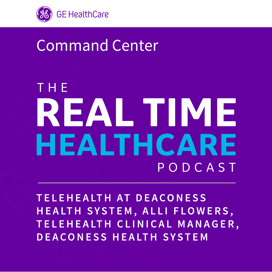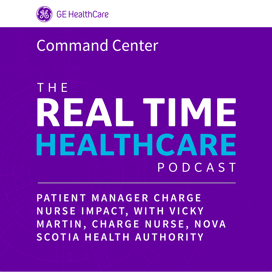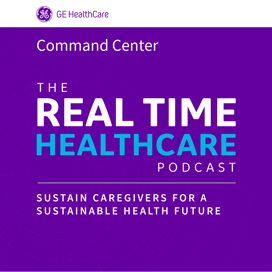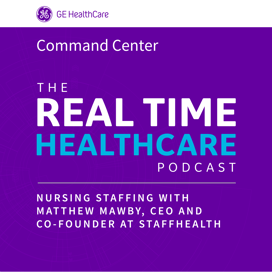#44 - Medication Management with Chief Medical Officer Dr. Colin Banas with DrFirst
Oct 11 · 12:28 min
In this Episode:
Making medication management frictionless helps health systems prevent negative outcomes, adverse drug events and readmissions. In this episode, Jeff Terry is joined by Dr. Colin Banas, CMO at Dr. First. They’re talking about how to add efficiency and accuracy to processes like medication reconciliation and the important role of a care communication platform that can reach beyond the four walls of the hospital.
Jeff Terry:
Hello and welcome. I'm Jeff Terry. Delighted to be joined today by Dr. Colin Banas, who's the Chief Medical Officer of DrFirst, which is a 21 year old health IT company involved with medication management and all sorts of AI that we're going to learn about. Good morning, Dr. Banas.
Dr. Colin Banas:
Good morning, Jeff. Thanks for having me.
Jeff Terry:
My pleasure. So yeah, start us off, Dr. Banas. DrFirst, a bit about the history. What problem does it solve? How do you help?
Dr. Colin Banas:
Yeah. As you mentioned before, a 21 year old innovative health IT company. Really, we cut our teeth in e-prescribing way back in the early 2000s, and from there, a whole host of innovative solutions have sprung up over time. A lot of which are, as you mentioned, centered around medication management, medication safety, and improving patient outcomes by keeping patients safe and keeping them on therapy. To answer the question of, what do we hope to achieve? The word I like to come back to is friction and reducing that friction. Whether it's for the provider trying to do their work in caring for their patient, or even at the patient level, again, making sure they are safe and on therapy for their medications. There's a lot of pieces that we bring to bear in the life cycle of medication data and medication management that can reduce that friction and keep folks safe and more efficient.
Jeff Terry:
Heck yes, and our work is in a parallel sphere, but we sometimes use that word seamless, make it seamless for all involved, which is, of course, easier said than done. Can I ask you as a practical matter, how does the software manifest? I think you might have mentioned earlier, it connects to the EMR. How does it work in a practical way for the user?
Dr. Colin Banas:
There are, again, a multitude of solutions. I think when we think about the core medication management solutions, we really are talking about adjuncts to the EMR. So if you think about your traditional monolithic EMRs, your Epic, Cerner, Allscripts, Meditech, we have solutions that will seamlessly integrate into those core EMRs and deliver a better experience and a safer experience, particularly when it comes to medication management, and that's just the bundle around medication safety that I keep referring to.
Jeff Terry:
Brilliant. DrFirst is the company. There are many products. I've also heard you use this term, the "Healthiverse". What is the Healthiverse? What's your vision for that?
Dr. Colin Banas:
Yeah. I love that term. It's a tagline we adopted about two years ago now, and the way I like to describe it is, the universe of healthcare is complex and complicated, the Healthiverse, and we seek to Unite the Healthiverse. We want to bring all of those pieces and parts and players together again in a frictionless or seamless way so that we can really realize the promise of digitization that we've all been looking for over the past decade or so. And so I think we, as an industry, are getting better at, of course, the records are digital now for the most part. I think we're doing better with some semblance of interoperability, whether it's patient facing or provider to provider, but there's other players out there that DrFirst also seeks to unite.
Payers, for example. We want to bring the payer experience, the payer data into decision making for providers and payers. Pharmacies, there's a lot of Ps, as you've picked up on, patients, providers, pharmacies, and payers. But we want to unite all of these things with the patient being in the center so that we can deliver a much better experience and, again, all centered around improved outcomes and improved efficiency.
Jeff Terry:
Brilliant. And DrFirst with 21 years is really relatively an older health IT company. I mean, it's been around longer than many, for sure, which gives you many advantages. But you've also started to bring AI into your work, which is useful obviously with divergent data sources and heterogeneous data and all that. So how do you use DrFirst to create more insight to whomever?
Dr. Colin Banas:
Yeah, great question. Recently, I've been trying to move away from the term artificial intelligence and trying to use augmented or advanced intelligence just because I think it's a little less cold, if you will. But we actually have a number of patents around the way that we can digest medication data. So if you think about the workflow, for example, of a doctor or a nurse doing medication reconciliation, so this idea of you showing up to the ER or in the clinic and I need to get a list of all of your medications and I need to start to make decisions about, do I continue these? Do I change them? Do I stop them? Well, the data that traditionally you're bringing in can be largely unstructured, particularly the instructions for a prescription. So we might be very good at saying, "Oh, I see you're on Lipitor 40 milligrams," but the instruction piece might be missing. Take one tablet by mouth daily.
What our AI can do, and again, it's patented for over a decade now, we can turn the unstructured back into structure so that when you are needing to consume it for your EMR, it comes seamlessly. It comes in safely. You're saving all sorts of clicks and keystrokes by not having to re-input that data and you're also, of course, making the patient safer because you're getting it right. There's no opportunities for the one to turn into an 11 because you held down the one key too long. And so just for the example of medication reconciliation, we're talking on the order of 20 to 30 seconds saved per medication recorded. And if you think about a complex geriatric patient, maybe 10 to 15 medications, this stuff can start to real really add up in terms of efficiency.
I want to take that idea and migrate it to something that you just referred to a second ago, which is data migration, because we can actually do this same kind of AI cleansing and landing with large data sets as well. So if you think about health information exchanges or you think about a hospital scooping up another practice and needing to migrate the old EMR data into the new EMR, again, we can use those same principles to do it very safely and very efficiently. And it's all under the moniker of "Smart". So if you hear DrFirst refer to something as "Smart", so, for example, "Smart SIG", "Smart processor", that is our patent around this medication management technology.
Jeff Terry:
That's brilliant. It makes a ton of sense. I want to get to outcomes, but just as a preamble to that or it connects is, you use the word efficiency, if I'm saving the physician 15 or 20 seconds of research per 10 medication, that's a lot of efficiency, but we know from our parallel work is that efficiency also translates to quality because sometimes there isn't time, you don't have five minutes to mess around with this and so you make an assumption or you miss something. And so clicks and efficiency is hugely important, but obviously there's a quality, I would imagine, there's a quality link to this as well. So how does DrFirst measure success? What outcomes have you seen?
Dr. Colin Banas:
Yeah. So I think the two big buckets, and we keep talking about it, we are very good at measuring the efficiency gains. So we've made pharmacy techs, for example, who were previously seeing 10 patients per shift and trying to get this medication data, now they're seeing 15 patients. And whether you are hiring less pharmacy techs or likely you are repurposing pharmacy talent to go do other safety initiatives, you're gaining something back. And then the quality side, again, as a former CMIO and having sat on all of these serious safety events and adverse drug event committees, what we bring to bear in terms of improving safety is, actually, definitely more important to me. And one of the honors I have in my role as CMO is I lead up our Applied Clinical Research Team. So I actually have a team of clinicians who are studying in real time the impacts that our solution suite is having on patient outcomes and on health systems.
And a great example is a health system in Massachusetts turned on our solution suite maybe six months ago. Not only, of course, did we make them more efficient and we measured that, but we also started to see a significant decline in the number of medication errors that are reaching patients on the order of 20% and a decline in serious safety events or adverse drug events as well. And, of course, you can apply that to traditional research models and say, "There is a massive ROI in terms of preventing readmissions, negative outcomes, et cetera, simply from getting something like the med list correct and getting medication management accurate from the very beginning."
Jeff Terry:
Oh, man. We see it all the time, friction leads to the fog of war and confusion and chaos, and that clearly tends to depress outcomes. So when you clear that, the opposite happens. That's brilliant. Two last questions, but one real quick one I guess is, you mentioned the medication management related products a few times. Can you just quickly mention some of the other spaces DrFirst is active in?
Dr. Colin Banas:
Sure. We have a care collaboration platform that we call Backline, which is the ability to do secure communications, not only within the four walls of your hospital, clinic, or health system, but also reach patients in a secure manner or external providers using this solution suite. You can do almost everything with Backline. You can exchange content. You can do e-signatures. So perhaps the pre-op visit in the era of COVID needs to happen over telehealth. And, of course, our solution also does telehealth, I should say. And so you could be doing the entire visit on Backline as well as pushing content back and forth and getting things signed.
But I think what's really great about that particular solution is the ability to touch folks who aren't necessarily in my health system. Where I came from before I could only page or text message securely other doctors or clinicians within my ecosystem. And with something like Backline, you can reach outside those four walls. And I think with COVID, you're seeing really the advance of hospital at home, healthcare without walls. We're really seeing a new paradigm where this kind of technology has become an absolute necessity going forward.
Jeff Terry:
Some silver lining in that, for sure, and real innovation. Brilliant. I love the name by the way, Backline. So last question for our audience who do want to get more information about any of this. How do they track you down?
Dr. Colin Banas:
Sure. I am available on most of the social media platforms. So you could find me on LinkedIn. You can find me on Twitter, in fact, @Colin_Banas. I'm a big emailer, so email away, cbanas@drfirst.com. And, of course, we have a very robust and interactive website at www.drfirst.com as well. But I can't thank you enough for having me this morning. This has been exciting.
Jeff Terry:
Brilliant. My pleasure. Great learning. It sounds like very impressive work. So thank you very much.
Dr. Colin Banas:
Thank you.
Jeff Terry:
And with that, I will close the podcast.







